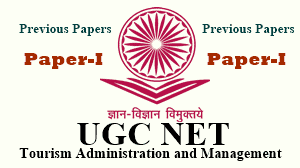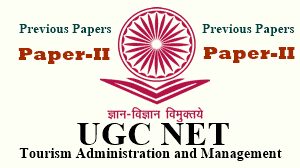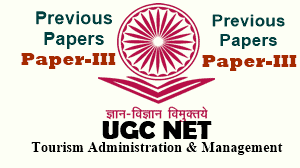UGC NET Tourism Administration and Management June 2013 Paper-II
1. A type of tourist who seeks novelty at all costs even discomfort and danger and avoids contact with other tourists
(A) Drifter
(B) Adventurer
(C) Psychocentric
(D) Diver
2. During which period India celebrated “Explore India Year” ?
(A) 1981 – 1982
(B) 1991 – 1992
(C) 1999 – 2000
(D) 2009 – 2010
3. The term ‘Gastronomy” refers to an aspect of
(A) Space tourism
(B) Medical tourism
(C) Cultural tourism
(D) Marine tourism
4. The headquarter of UNWTO is situated at
(A) Paris (B) London
(C) New York (D) Madrid
5. Where is the headquarter of World Travel and Tourism Council (WTTC) ?
(A) Brussels (B) Madrid
(C) Amsterdam (D) Rome
6. Mughal official name of Tajmahal is
(A) Begum Mumtaz Makbara
(B) Roza-i Munawwara
(C) Roza-i Mumtaz Begum
(D) Roza-i Mumtaz Mahal
7. Complete tourism study should comprise the study of
(A) Geography, environment and ecology
(B) History, heritage and culture
(C) Economics and Management
(D) All of the above
8. Imambara is
(A) a congregational mosque
(B) a large hall for observing Muharram and for storing tazias
(C) audience hall
(D) a residential centre for spiritual study
9. What is equivalent of one nautical mile, used in aviation and shipping ?
(A) 1.852 km
(B) 1.610 km
(C) 1.230 km
(D) 1.100 km
10. Match List – I with List – II :
List – I List – II
(River) (Origin of place)
I. Narmada 1. Mahabaleshwar
II. Tapi 2. Brahmagiri
III. Kaveri 3. Betul
IV. Krishna 4. Amarkantak
Codes :
I II III IV
(A) 4 3 2 1
(B) 4 2 3 1
(C) 1 2 3 4
(D) 2 1 4 3
11. The coral reefs in India are found at
I. The Gulf of Mannar
II. Andaman and Nicobar Islands
III. Lakshadweep Islands
IV. Diu Island
Codes :
(A) I, II, III and IV are correct.
(B) I, II, III and IV are not correct.
(C) I, II and III are only correct.
(D) I, III and IV are only correct.
12. Avoidance, accommodating, competing, compromising and collaborating are the five options available for
(A) Organisational conflict resolution
(B) Employee dispute resolution
(C) Labour dispute resolution
(D) Industrial dispute resolution
13. Kitchen profit is also termed as gross profit and is calculated on the basis of the formula
(A) Sales – Food cost + Labour cost = Kitchen profit or Gross profit
(B) Sales – Food cost = Kitchen profit or Gross profit
(C) Sales – Ingredient cost + Labour cost = Kitchen profit or Gross profit
(D) Sales – Overheads + Labour cost = Kitchen profit or Gross profit
14. Kitchen stewarding in a hotel is responsible for
(A) Wine service
(B) Garbage disposal
(C) Salad preparation
(D) Still room
15. Match List – I with List – II :
List – I List – II
(Term) (Statements)
I. Continental Plan 1. No meals are included in the room tariff
II. Modified American Plan 2. All meals are included in the room tariff
III. American Plan 3. Only breakfast is included in the room tariff
IV. European Plan 4. Breakfast and one meal is included in the room tariff
Codes :
I II III IV
(A) 2 3 1 4
(B) 1 2 4 3
(C) 4 1 3 2
(D) 3 4 2 1
16. Which cruise ship was grounded off
at Tuscan Island (near Italy) on
January 16, 2012 ?
(A) Star Cruise
(B) Oasis
(C) Costa Concordia
(D) Elizabeth
17. Which is the largest cruise ship in the world ?
(A) Oasis
(B) Queen Merry II
(C) Star Libra
(D) RCCL Caribbean
18. Which is not a major sea port of India ?
(A) Ennore
(B) Tuticorin
(C) Vishakhapatnam
(D) Yanam
19. What percentage of oxygen is used in gas cylinder of SCUBA diving ?
(A) 100 % (B) 80 %
(C) 60 % (D) 50 %
20. According to the survey by National Geographic and International Poling firm Globescan on 17 large countries, which country stands first in “Greendex-2010” for better environment ?
(A) Brazil
(B) New Zealand
(C) South Africa
(D) India
21. Match List – I with List – II :
List – I List – II
(Name of the Company / Travel agency) (Year of establishment)
I. Thomas Cook India Ltd. 1. 1963
II. SITA World Travel, India 2. 1948
III. Mercury Travels 3. 1978
IV. Travel Corporation of India (TCI) 4. 1961
Codes :
I II III IV
(A) 1 3 4 2
(B) 4 1 2 3
(C) 3 1 2 4
(D) 2 4 1 3
22. J.N. Katgara is described as the first Indian to establish the travel agency business in India. Name the agency which he established in 1920.
(A) Jeena & Company
(B) Lee & Muirhead India Pvt. Ltd.
(C) Jamnadas and Co. Ltd.
(D) Mercury Travels
23. In which city, Office of Bureau of Immigration is not located ?
(A) Hyderabad
(B) Amritsar
(C) Varanasi
(D) Bangaluru
24. Match List – I with List – II :
List – I List – II
(Type of US Visa) (Description)
I. F-1 1. Visitor Visa Tourism
II. M 2. Foreign Student Visa
III. B-2 3. Vocational Student
IV. I 4. Foreign Media
Codes :
I II III IV
(A) 2 3 1 4
(B) 3 2 1 4
(C) 2 1 3 4
(D) 1 2 3 4
25. Who was the most influential travel agent in Egypt during the last quarter of 19th century?
(A) J.N. Katgara
(B) John Thompson
(C) John Mason Cook
(D) Cox
26. The people element in service marketing mix includes
(A) Customers only
(B) Employees only
(C) All human actors
(D) Suppliers only
27. A customer in a bar purchasing a glass of beer may go right to the purchase decision skipping information search and evaluation is referred
(A) Automatic response loop
(B) Post purchase behaviour
(C) Consumer response management
(D) Customer relationship
28. Who adopted the product life cycle model to the tourism industry and created Tourism Area Life Cycle Theory in 1980 ?
(A) Baum Tom
(B) Butler R.W.
(C) Cooper, Chris
(D) Oliver R.L.
29. Markets segmented into lightmedium and heavy user groups refers to
(A) Psychographic segmentation
(B) Behavioural segmentation
(C) Demographic segmentation
(D) Geographic segmentation
30. Market coverage strategies include
(A) Concentrated marketing
(B) Structural attractiveness
(C) Physical attribute differentiation
(D) Order routine specification
31. Necessary involvement of the service providers emotions in the delivery of service is termed as
(A) Service culture
(B) Organisation culture
(C) Emotional labour
(D) Emotional appeals
32. In recreational planning, a new technique was followed from 1990 and it is defined as follows. Indicate the correct definition.
(A) It is known as carrying capacity technique
(B) It is known as Delphi technique.
(C) It is known as recreation and tourism planning.
(D) Recreational planning and managements.
33. “Incredible India” campaign was launched in the year
(A) 2000 (B) 2001
(C) 2002 (D) 2003
34. In 1975 the Irritation Index Theory was presented by
(A) Butler, R.W (B) Doxey, GV
(C) Roxy, D.C (D) Jaffri, J
35. Match List – I with List – II :
List – I List – II
(Measurement of Scale) (Example of scale)
I. Nominal 1. Attitudinal Scale : 10-20, 21-30,31-40, 41-50 etc.
II. Ordinal 2. Attitude : Favourable – unfavourable
III. Infernal 3. Income above average, Average, below average
IV. Ratio 4. Age, years/ months
Codes :
I II III IV
(A) 2 4 2 1
(B) 2 3 1 4
(C) 1 2 3 4
(D) 3 2 1 4
36. Match List – I with List – II :
List – I List – II
(Types of Studies) (Characteristics)
I. Trend Studies 1. Cross-sectional or longitudinal
II. Cohort Studies 2. Through analysis of an individual
III. Case Studies 3. Placebo experimental design
IV. Blind Studies 4. Past, Present and future
Codes :
I II III IV
(A) 1 3 4 2
(B) 2 3 1 4
(C) 4 1 2 3
(D) 3 2 1 4
37. Relationship of two or more variables is examined excluding some other variables in case of
(A) Complex correlations
(B) Multiple correlations
(C) Partial correlations
(D) Single correlations
38. The central unit indicates the sample distribution of means when it
(A) is always normal
(B) is always normal for large sample size
(C) approaches normality due to increase in sample size
(D) approaches normality only when it exceeds more than 10,000 sample size
39. Cross-sectional research design is described as
(A) a type of research design used to gather data from the entire population more than once.
(B) a type of research design applied to assimilation of data from an identified population frequency.
(C) a type of research design involved to collect information from a small sample in two successive times.
(D) a type of research design involving the collection of information from any given sample population elements only once.
40. Emigration check not required
(ECNR), status passport are granted to
I. Indian Nationals from abroad
II. All holders of diplomatic passport
III. All income tax payers
IV. All graduates and professional
degree holders
Codes :
(A) I, II, III are correct.
(B) II, III & IV are correct.
(C) All of the above are correct.
(D) Only IV is correct.
41. Repetitiveness is identified as a major dimension of
(A) Communicating
(B) Directing
(C) Leadership
(D) Planning
42. According to Maslow’s Theory of Need Hierarchy
(A) Higher order needs would be satisfied first.
(B) Lower order needs would be satisfied first.
(C) There is no pattern of satisfaction of need.
(D) Need and wants are one and same.
43. Measuring performance, comparing measured performance to standards and taking corrective action are the three main steps in
(A) Directing process
(B) Controlling process
(C) Planning process
(D) Communicating process
44. The minimum rate of return, which the investors of firm expect to earn on its investment proposal is called
(A) Cost of capital
(B) Value of investment
(C) Inflows
(D) Current liabilities
45. Which one of the following is not a trading account item ?
(A) Purchases
(B) Fuel
(C) Power
(D) Salary to Sales Manager
Read the passage below and answer the questions that follow based on understanding of the passage Answer (46 – 50) :
The Collage Technique
Collage (Schlackman, 1989 : Solomon et al., 1999; Schiffman and Kanuk 2000 : Moisander and Valtonen, 2006) is a projective technique that can be described as a method in which participants are asked to represent a topic or phenomenon visually by composing and gluing together a collage of images drawings and texts on a piece of cardboard or paper (Moisander and Valtonen, 2006; 96). From this representation, an interpretation is made using a perceptual diagram that differentiates three perceptual levels; observation level, evaluative level and levels of values and feelings.
The observation level considers the most objective image about the resources of the city, including tangible resources, such as infrastructure, urban development and buildings and intangible resources such as traditions, customs and personality traits associated with the residents (Kotler et al., 1993.) The evaluative level reveals their attitudes towards each one of the issues identified in the preceding level and, finally, the last level reflects the subjective perception of the city, linked with the values and feelings that it transmits (Laaksonen et al., 2006).
46. Collage technique is
(A) to show the images of destinations to the tourists.
(B) to provide accommodation on cheaper rate.
(C) to provide travelling cost.
(D) to display peculiar sites to the tourists.
47. Collage research method is
(A) Quantitative method of research
(B) Qualitative method of research
(C) Survey and data collection method
(D) Snow-balling method
48. Tangible resources are
(A) Infrastructure
(B) Urban development
(C) Buildings
(D) All of the above
49. Intangible resources are
(A) Palaces to visit
(B) Hotels to stay
(C) Restaurant to eat
(D) None of the above
50. Collage Research Method represents
(A) Neutral image of the city
(B) Subjective Perception of the city
(C) Objective Perception of the city
(D) Traditional image of the city



